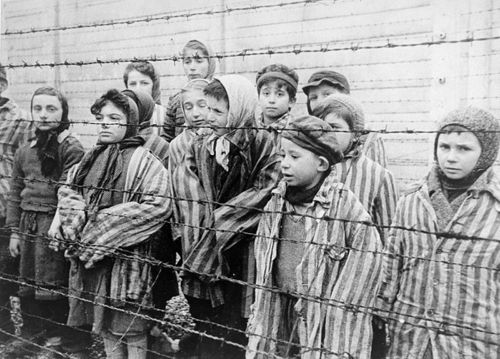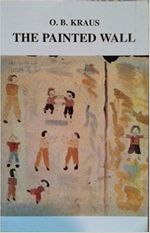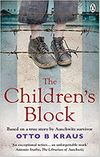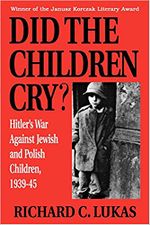Category:Holocaust Children Studies--1990s
|
|
Holocaust Children Studies : 2020s -- 2010s -- 2000s -- 1990s -- 1980s -- 1970s -- 1960s -- 1950s -- 1940s -- 1930s -- Home General : 2020s -- 2010s -- 2000s -- 1990s -- 1980s -- 1970s -- 1960s -- 1950s -- 1940s -- 1930s -- 1920s -- 1910s -- 1900s -- 1850s -- 1800s -- 1700s -- 1600s -- 1500s -- 1450s -- Medieval -- Home
|
1994 (a)
Ota B. Kraus. The Painted Wall / The Children's Block (Tel-Aviv : Yaron Golan Publ., 1994). Repr. London: Ebury Press, 2019. Also translated into German (2002).
A semi-fictional account, based on his own personal experience.
"In the novel The Painted Wall, Otto (Ota) B. Kraus writes about his own experience in Auschwitz during WWII. Otto was one of the instructors in the children's block and his (future) wife Dita, was the librarian for the children, of whom only a handfull survived. The book, which was originally named "The Diary", was written after the war. The story of a diary is but a literary introduction, yet the events described in the book are real. The Painted Wall tells the true story of 500 Jewish children who lived in the Czech Family Camp in Auschwitz-Birkenau between September 1943 and June 1944. The children were kept on a Children's Block supervised by the notorious Dr. Mengele, where their instructors organized clandestine lessons, singalongs and even staged little plays and charades. The Children's Block was intended to provide the Nazis with an alibi to refute the rumors of the Final Solution. As long as the Children's Block existed, it was a shelter and haven for the hundreds of children, who soon afterwards perished in the gas chambers."--Publisher description.
Ota "Otto" B. Kraus (1921-2000) was born and raised in Prague to a Jewish family. In May 1942 he was confined with his family to Ghetto Terezin . In December 1943 he was deported to Auschwitz, where at the time the Nazis had established a special family camps for those arriving from Terezin. Otto became one of the children’s counselors on the Kinderblock, a special barracks where the children were kept during the day. After a few months the camp was liquidated and the inmates were almost all sent to the gas chambers. Otto was one of the few selected to survive as labor force. A fervent Zionist, after the war he settled to Israel, where he was a teacher and writer.
1994 (b)
Richard C. Lukas. Did the Children Cry?: Hitler's War Against Jewish and Polish Children (New York, NY: Hippocrene Books, 1994).
"An unprecedented aspect of Nazi genocide in World War II was the cold and deliberate decision not to spare the children. Jewish children, first driven into the ghettos, were marked for total destruction as part of the "Final Solution" once it was put into effect, in 1942. Gentile children were starved, killed, or Germanized in order to reduce the Polish nation to a small complement of semi-literate slaves tending the Herrenvolk in their thousand-year Reich. This record also includes accounts of how they fought back by working for the underground, smuggling food into the ghettos, attending secret classes to continue their forbidden education. Included are stories of villains like Mengele who selected children for execution during Jewish religious holidays; Rudolph Hoess, Auschwitz's commandant who admitted his own discomfort when he witnessed the gassing of prisoners with the excuse: "I was a soldier and an officer"; a heroic Dr. Janusz Korczak who was in charge of an orphanage in the ghetto, but refused to leave his orphans, and at the head of a contingent of 192 children and 8 staff members, erect, his eyes looking into the distance, held the hands of two children as he led them to the railroad platform where trains took them to certain death. Based on vast research in the United States, Great Britain, and Poland, many interviews, theses and other papers, documents and official histories, memoirs, autobiographies, articles, periodicals and newspapers, Did the Children Cry? stands as a monument to millions of children who were bombed, wounded, deported, raped, starved, maimed, subjected to "medical" experimentation, and killed in German-occupied Poland."--Publisher description.
Richard C. Lukas (b.1937) is an American historian and author of books and articles on military, diplomatic, Polish, and Polish-American history. He specializes in the history of Poland during World War II.
1995
- Le mémorial des enfants juifs déportés de France (French children of the Holocaust / 1995, 1996
Subcategories
This category has only the following subcategory.
Media in category "Holocaust Children Studies--1990s"
The following 82 files are in this category, out of 82 total.
- 1990 Holland (film).jpg 332 × 475; 39 KB
- 1990 Lagnado.jpg 322 × 499; 38 KB
- 1990 Perel.jpg 324 × 499; 25 KB
- 1990 Wajda (film).jpg 208 × 300; 31 KB
- 1991 Brown.jpg 1,424 × 1,808; 525 KB
- 1991 Durlacher nl.jpg 120 × 200; 6 KB
- 1991 Dwork.jpg 339 × 499; 36 KB
- 1991 Gilbert.jpg 325 × 499; 31 KB
- 1991 Muller.jpg 351 × 499; 29 KB
- 1991 Urman.jpg 324 × 499; 27 KB
- 1992 Drucker.jpg 333 × 499; 38 KB
- 1992 Kertész.jpg 325 × 500; 33 KB
- 1992 Lindwer.jpg 318 × 499; 27 KB
- 1992 Van Wanegen film.png 252 × 396; 214 KB
- 1993 Faenza film.jpg 262 × 379; 23 KB
- 1993 Marks.jpg 322 × 499; 31 KB
- 1993 Matas.jpg 400 × 608; 81 KB
- 1993 Oberski it.jpg 201 × 339; 9 KB
- 1993 Pacifici.jpg 201 × 306; 6 KB
- 1993 Rubin.jpg 350 × 499; 24 KB
- 1993 Toll.jpg 322 × 499; 40 KB
- 1993 Valent.jpg 324 × 499; 30 KB
- 1994 Birenbaum en.jpg 333 × 499; 26 KB
- 1994 Kestenberg.jpg 314 × 499; 18 KB
- 1994 Kraus.jpg 321 × 499; 21 KB
- 1994 Levi.jpg 333 × 500; 30 KB
- 1994 Lukas.jpg 333 × 499; 40 KB
- 1994 Miller.jpg 339 × 499; 24 KB
- 1994 Rabinovici.jpg 327 × 499; 38 KB
- 1994 Rosenberg.jpg 310 × 474; 31 KB
- 1994 Stein.jpg 296 × 474; 23 KB
- 1994 Treves.jpg 201 × 293; 4 KB
- 1995 Akavia.jpg 318 × 499; 23 KB
- 1995 Blair doc.jpg 580 × 859; 100 KB
- 1995 Blend.jpg 400 × 625; 34 KB
- 1995 Boas.jpg 334 × 499; 30 KB
- 1995 Bricarelli.jpg 204 × 300; 5 KB
- 1995 Frank en.jpg 400 × 661; 218 KB
- 1995 Graver (book).jpg 400 × 630; 32 KB
- 1995 Lee.jpg 336 × 474; 19 KB
- 1995 Levi.jpg 187 × 266; 5 KB
- 1995 Machlin.jpg 310 × 475; 39 KB
- 1995 Nagaoka (film).jpg 267 × 372; 13 KB
- 1995 Pagnotti.jpg 327 × 499; 31 KB
- 1995 Starkopf.jpg 332 × 499; 22 KB
- 1995 Zargani.jpg 319 × 499; 27 KB
- 1996 Bennett (play).jpg 300 × 436; 52 KB
- 1996 David 2.jpg 177 × 250; 9 KB
- 1996 Hochberg - Grüss en.jpg 326 × 499; 39 KB
- 1996 Kestenberg.jpg 429 × 640; 77 KB
- 1996 Lazan.jpg 326 × 499; 23 KB
- 1996 Werber.jpg 308 × 499; 41 KB
- 1997 Bender (film).jpg 1,000 × 1,855; 156 KB
- 1997 Benigni (film).jpg 262 × 379; 28 KB
- 1997 Brenner.jpg 400 × 599; 126 KB
- 1997 Gold.jpg 400 × 586; 34 KB
- 1997 Kragh-Jacobsen film.jpg 1,000 × 1,400; 129 KB
- 1997 Maarsen en.jpg 1,920 × 2,560; 266 KB
- 1997 Melnick (book).jpg 400 × 648; 22 KB
- 1997 Minac (film).jpg 334 × 475; 26 KB
- 1997 Rimini.jpg 336 × 499; 17 KB
- 1997b Bitton-Jackson.jpg 298 × 500; 40 KB
- 1997b Winter.jpg 311 × 499; 24 KB
- 1998 Durlacher en.jpg 292 × 499; 26 KB
- 1998 Immell (ed).jpg 312 × 500; 33 KB
- 1998 Kestenberg.jpg 314 × 499; 19 KB
- 1998 Muller de.jpg 312 × 500; 29 KB
- 1998 Müller (book).jpg 334 × 499; 24 KB
- 1998 Müller en (book).jpg 400 × 606; 30 KB
- 1998 Nieuwsma.jpg 375 × 499; 28 KB
- 1998 Rabinovici en.jpg 323 × 499; 37 KB
- 1998 Rittner (ed).jpg 346 × 499; 15 KB
- 1999 Bloom (ed).jpg 226 × 350; 14 KB
- 1999 Fleischmann.jpg 338 × 499; 15 KB
- 1999 Fox.jpg 410 × 500; 36 KB
- 1999 Harris.jpg 324 × 499; 21 KB
- 1999 Justman (doc).jpg 1,000 × 1,333; 129 KB
- 1999 Kertész it.jpg 324 × 499; 25 KB
- 1999 Kustanowitz.jpg 371 × 499; 24 KB
- 1999 Minsky.jpg 332 × 499; 30 KB
- 1999 Segre (book).jpg 699 × 1,174; 149 KB
- 1999 Varon.jpg 328 × 499; 20 KB























































































